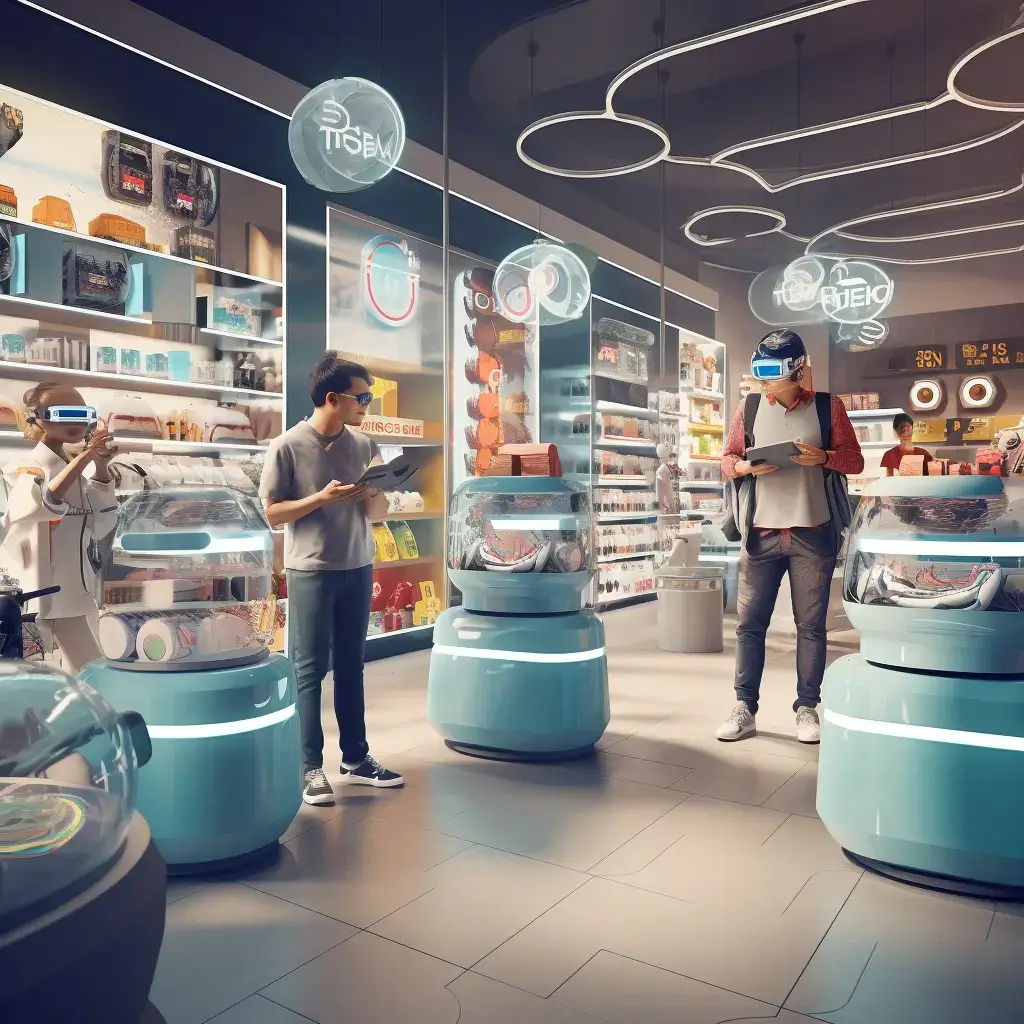Imagine a world where you’re free to shop at your fingertips without the constraints of location or time. The COVID-19 pandemic has accelerated the rise of e-commerce and changed how we think about shopping forever. As a consumer in this new landscape, you now have unprecedented product access. And experiences that cater to your every whim. At the same time, Ecommerce After Covid businesses adapt rapidly to keep up with these evolving demands.
This insightful article explores how digital technologies have reshaped consumer behavior and driven supply chain resilience and sustainability innovation. We’ll also discuss the future of traditional brick-and-mortar retail as e-commerce continues its meteoric ascent. So please sit back, relax, and embark on this journey with us toward freedom in shopping. Because when it comes to e-commerce after COVID-19, there’s no looking back!
The Digital Price Index (DPI), published by Adobe, offers a comprehensive overview of online consumer goods prices.
Key Takeaways
- E-commerce experienced unprecedented growth due to the pandemic and reshaped consumer behavior.
- Diversifying, risk management, and automation can achieve supply chain resilience.
- Sustainability is increasingly important to customers. And implementing sustainable practices can attract a broader customer base and save costs.
- Through technology, personalized customer interactions, and community engagement, online retail reinvention can elevate the storefront experience—and future-proof businesses against potential disruptions.
Table of Contents
ToggleThe Rise of Digital Technologies

You can’t ignore the rise of digital technologies. They’re shaping our new eCommerce reality and transforming how we shop post-COVID. Digital innovation has accelerated astonishingly, making accessing products and services from the comfort of your home more accessible. The pandemic has pushed businesses to prioritize technology adoption. It enables them to meet the evolving needs of their customers and stay competitive in a rapidly changing landscape.
Embracing digital technologies is not just about keeping up with the times. It’s about unlocking a world of possibilities that empowers you to live on your terms. No more waiting in line or being limited by store hours. With just a few clicks or taps, you can explore countless online stores, compare prices, read reviews, and make informed online purchase decisions. Furthermore, advanced personalization algorithms and AI-powered recommendations ensure you’ll discover products tailored to your tastes and preferences.
As we adapt to this new normal brought on by COVID-19. Businesses and consumers must recognize the potential for massive growth through digital technologies. By harnessing these innovations in eCommerce, we can create a shopping experience that saves time while delivering precisely what each desires—giving us all greater freedom in spending our time and money. As we delve deeper into this transformative era, we examine how evolving consumer behavior is. Significantly shapes our future interactions with eCommerce platforms.
Evolving Consumer Behavior

As you navigate the world of eCommerce after COVID-19, it’s essential to understand how consumer behavior has evolved. People now place a higher emphasis on health and safety while also showing a growing preference for local and sustainable products. Embracing these changes can help you create an online shopping experience that aligns with your customer’s values and expectations, ultimately driving success in this new landscape.
Focus on Health and Safety
You’ll want to prioritize health and safety in your e-commerce business, as customers are more cautious. Implementing stringent health regulations and safety protocols will put their minds at ease and demonstrate your commitment to their well-being. By doing so, you’re catering to the growing desire for freedom from worry that your audience craves while positioning your brand as a trustworthy partner during these uncertain times.
As you adapt to the changing landscape and customer needs, you must stay ahead of the curve by embracing trends. Such as a preference for local and sustainable products. In doing so, you’ll provide an avenue for customers seeking both quality goods and a sense of freedom from global supply chain uncertainties.
Preference for Local and Sustainable Products
Embracing the trend of local and sustainable products is critical to staying ahead in today’s market. It allows you to cater to customers seeking high-quality goods while alleviating global supply chain concerns. You’ll attract environmentally-conscious consumers by fostering local customer loyalty and focusing on sustainable sourcing. It strengthens your brand image as a responsible and forward-thinking business.
Consider these compelling reasons for prioritizing local and sustainable products:
| Reason | Benefits | Impact |
|---|---|---|
| Local loyalty | Greater customer trust, stronger community ties | Increased repeat business, positive word-of-mouth |
| Sustainable sourcing | Reduced environmental impact, ethical production practices | Enhanced brand reputation, appeal to eco-conscious consumers |
| Supply chain resilience | Less reliance on international suppliers, faster response times | Improved flexibility during disruptions, higher customer satisfaction |
| Economic support | Investment in the local economy, job creation | Long-term growth rates potential for both business and community |
| Consumer trends | Growing demand for eco-friendly products and desire for transparency in production processes. | Meeting evolving consumer expectations |
With these benefits in mind, it’s clear that shifting towards locally-sourced and sustainably-produced offerings is a smart move. As you continue adapting your eCommerce strategy post-COVID-19 era, remember that integrating such practices will not only meet changing consumer demands. But it also helps ensure the long-term success of your business. Next up: let’s explore the importance of supply chain resilience.
The Importance of Supply Chain Resilience

As you navigate the ever-changing world of eCommerce, understanding the importance of supply chain resilience is crucial for success. Embracing diversification and risk management can help mitigate disruptions while incorporating automation and robotics streamlines operations and bolsters efficiency. Don’t underestimate these key strategies to ensure your business thrives in a post-pandemic landscape.
Diversification and Risk Management
By spreading your investments across various channels, you’ll create a safety net to cushion any potential blows to your e-commerce business. Implementing diversification strategies and risk mitigation techniques will ensure you won’t have all your eggs in one basket. They allow you to adapt quickly if unforeseen circumstances arise. This flexibility safeguards your financial well-being and allows you to explore new opportunities and grow your business.
- Supplier Diversification: Working with multiple suppliers can help reduce the risk of supply chain disruptions. It ensures that you always have access to products for your customers.
- Market Diversification: Expanding into new markets or segments helps spread risk by tapping into diverse customer bases and reducing dependence on a single call.
- Channel Diversification: Utilizing various sales channels (such as so
- Having witnessed a peak in online sales during the pandemic, eCommerce will remain an integral part of most companies in the future.
- Social media platforms, online marketplaces, and brick-and-mortar stores) allows you to reach more customers while minimizing risks associated with overreliance on one track.
While focusing on these diversification efforts may require additional time and resources upfront, the long-term benefits are invaluable. Especially when navigating through uncertain times like post-COVID recovery periods. As you continue optimizing and expanding your e-commerce operations. Consider how embracing automation and robotics can strengthen resilience in this ever-evolving landscape.
The Role of Automation and Robotics
In today’s fast-paced world, incorporating automation and robotics into your e-commerce business can significantly boost efficiency, productivity, and resilience. By leveraging the power of robotic efficiency, you can streamline your operations and reduce the need for manual labor. It allows you to focus on other critical aspects of your business. Automation advancements have enabled companies of all sizes to automate processes like order fulfillment, inventory management, and customer service – giving you more time to concentrate on growth strategies while ensuring a consistent customer experience.
As technology advances at lightning speed, embracing automation and robotics in your e-commerce operations will help future-proof your business against potential disruptions. Not only will this give you a competitive edge in an increasingly crowded market, but adopting these technologies will also play a significant role in supporting sustainability goals within the industry. By minimizing waste through precision manufacturing processes and optimizing energy usage with innovative systems integration, you’ll be taking steps towards building a greener future for e-commerce overall – leading seamlessly into our subsequent discussion on sustainability in e-commerce.
Sustainability in E-commerce

You’ll find that sustainability in e-commerce is more important than ever as customers increasingly value eco-friendly options and long-term solutions. By implementing sustainable packaging and promoting eco-friendly initiatives within your business, you can attract a broader customer base while contributing to the global effort of reducing environmental impact. Not only does this help build trust with consumers who prioritize green practices, but it will also set your brand apart from competitors who are slow to adopt these changes.
Embracing sustainability in e-commerce
Embracing sustainability in e-commerce goes beyond just using recyclable materials; it’s about making conscious choices throughout all business operations. This includes everything from sourcing products made with sustainable materials or methods to utilizing renewable energy sources for powering warehouses and offices. Additionally, consider offering carbon-neutral shipping options or partnering with environmentally-conscious logistics providers. These steps will enhance your company’s reputation among eco-minded shoppers and may even lead to cost savings through reduced waste and increased eCommerce Sales.
As the world continues to adapt and evolve post-COVID, so must businesses keep up with these changing demands – particularly regarding sustainability in e-commerce. By demonstrating a commitment to environmental responsibility now, you’re setting yourself up for success in an increasingly eco-conscious market while doing your part for the planet. As we look ahead toward the future of brick-and-mortar retail, it’s clear that adopting sustainable practices across all channels is crucial for staying relevant and maintaining a competitive edge in today’s rapidly evolving landscape.
Although there has been a decrease in traffic compared to previous years, the growth in traffic to DTC sites is still higher than pre-pandemic levels.
The growth in traffic to the top 27 eCommerce sites during April and May 2022 has been lower than in 2020.
Following the reopening of physical stores in June 2021, there was a decline in traffic towards DTC and eCommerce sites.
The yearly growth in traffic for Home and Garden DTCs continued to slow after May 2021. More and more people are shopping online using mobile phones in Europe.
The Future of Brick-and-Mortar Retail

Transitioning from the importance of sustainability in e-commerce, let’s examine another crucial aspect of the industry – the future of brick-and-mortar retail. As you adapt to the ever-evolving landscape of e-commerce, don’t forget that physical stores still play a significant role in your overall success. Retail reinvention and storefront innovations are essential for maintaining a competitive edge and capturing the hearts (and wallets) of consumers who crave unique experiences.
The future of brick-and-mortar retail sales is about creating immersive, engaging environments that fully integrate digital and physical elements. Consider these three key strategies to elevate your storefront experience:
- Utilize cutting-edge technology: Incorporate virtual, augmented reality, or bright fitting rooms to create unforgettable shopping experiences that keep customers returning.
- Personalize customer interactions: Leverage data-driven insights to tailor product recommendations or offer customized promotions based on individual preferences.
- Foster community engagement: Turn your store into a hub for workshops, personal events, or social gatherings that resonate with your target audience.
As you implement these strategies within your brick-and-mortar locations, remember that today’s consumer seeks freedom in in-person shopping experiences – the freedom to explore new products and ideas without constraints or limitations. Embrace this desire by offering unparalleled convenience online and offline while prioritizing sustainable practices across your operations.
By combining retail sales reinvention with storefront innovations and sustainability efforts in e-commerce, you’ll be well-positioned to thrive in whatever lies ahead for our post-COVID world. So take charge of your brand’s destiny; invest in forward-thinking technologies and strategies that cater to modern shoppers’ desires for freedom and authenticity while nurturing our planet at every step.
The Impact of the Pandemic on eCommerce: Before and After
After experiencing a surge in online sales during the pandemic, eCommerce penetration is expected to remain a crucial component of most companies in the future.
Due to inflation, there may be a decrease in consumer spending, which could potentially impact eCommerce companies with reduced website traffic and online sales.
Target experienced a 17% increase in online sales in 2020 compared to 2019, with a 4% yearly growth in 2019 compared to 2018.
In 2020, there was an increase in online sales of the Consumer Electronics Industry, building materials, garden equipment, general merchandise, food and beverage, and sporting goods.
Despite the decrease in eCommerce activity, major online retailers and brands that experienced a surge in online and offline sales during the pandemic will continue to engage with customers through various channels and utilize direct-to-consumer methods.
Credit and debit card data showed a significant increase of nearly 20 percent in online spending since January 2020, indicating a notable surge in e-commerce during the pandemic.
The pandemic has caused notable changes in business offerings and consumer preferences, which may impact the retail trade sector long-term.
Businesses should take note that these updates have the potential to replace standard Google Posts, which may have an impact on local SEO strategy. If you utilize Google Posts extensively for your local SEO strategy, removing the COVID-19 posts or modifying them to incorporate the same information as your regular posts is advisable. In March, Google ceased displaying new business reviews in Google My Business.
Discover the latest e-commerce trends and initiatives for 2022. As shoppers adapt to a changing e-commerce environment, brands and eCommerce retailers can achieve profitable growth in unique ways.
The COVID-19’s Impact on E-commerce Sales
For more information on the significant impact of coronavirus on various industries, you can explore the research conducted by DTCPPC. Additionally, it is essential to note that Black individuals in the U.S. have experienced higher rates of mortality and unemployment due to COVID-19, alongside racially charged police brutality.
Black Americans in Chicago make up 68% of coronavirus deaths, despite comprising only approximately 30% of the city’s population. The disparity can be explained by historical discrimination and inequality in America, which have led to limited access to resources for Black People, especially in financial security and personal care.
The lack of resources has resulted in a higher representation of Black people among low-wage essential workers who have had to continue working during the pandemic, despite potential health risks.
Furthermore, according to the Center for Responsible Lending, there was a 40% decrease in funding for Black-owned eCommerce businesses during the first round of the Paycheck Protection Program, designed to assist small business owners during the pandemic. Black people have faced a difficult time in starting and maintaining a small business in the first place.
Changes in eCommerce Stores Pre and Post COVID-19
There was a noticeable shift in consumer behavior, with more people cooking at home and opting for grocery delivery services.
The electronics sector is experiencing growth, and changes in demand and consumer habits benefit the industry.
Changing consumer habits are contributing to the expansion of the eCommerce sector.
Despite the data shown in the graph above indicating a return to in-store shopping due to the relaxation of restrictions, it is evident that the impact of COVID-19 has altered consumer behaviors.
Due to evolving consumer habits, such as reduced website usage and a desire for efficient results, we can offer solutions to meet customer satisfaction.
The evolution of online sales during the COVID-19 pandemic as in-person shopping resumed
The gap between in-store and e-commerce retail sales is shrinking as consumers return to department-store shopping, especially at health and personal care stores.
The COVID-19 pandemic has significantly impacted our lives, including how we shop. As in-person shopping resumed after the initial lockdowns, online sales experienced an evolution like never before. This article explores the changes and trends observed during this period and their implications for the future of online sales.
1. The Surge in Online Shopping
With physical stores temporarily closed and social distancing measures in place, online shopping became many consumers’ primary purchasing mode. This resulted in a significant surge in online penetration across various industries. People turned to e-commerce platforms, from groceries to electronics, to fulfill their needs.
2. The Rise of Contactless Delivery
To ensure the safety of both customers and delivery personnel, contactless delivery options became the norm. Many online retailers and delivery services implemented strict protocols to minimize physical contact during the delivery process. This added convenience and peace of mind for consumers, further increase in sales.
3. Shift in Consumer Behavior
As people spent more time at home, their purchasing behavior shifted. Non-essential items such as home décor, music stores, fitness equipment, and entertainment products saw a surge in demand. On the other hand, sectors like fashion and travel experienced a decline in sales as people postponed or canceled their plans.
4. Increased Adoption of Online Marketplaces
Online marketplaces like Amazon and Alibaba experienced exponential growth during this period. These platforms provided a wide range of products, quick delivery, and reliable customer service, making them the go-to choice for many consumers. Small businesses also turned to these marketplaces to reach a larger customer base.
5. Digital Marketing and Advertising Opportunities
With the increased reliance on online shopping, businesses had to adapt their marketing strategies accordingly. Digital marketing channels, such as social media advertising and influencer marketing, have become even more crucial in reaching and engaging customers. Companies that invested in online advertising and optimized their digital presence gained a competitive edge.
6. The Importance of Customer Experience
As online sales boomed, the importance of providing an exceptional customer experience became evident. Businesses that offered seamless website navigation, personalized recommendations, and efficient customer support thrived. Positive reviews and word-of-mouth referrals became crucial for attracting new customers.
7. Challenges and Opportunities for Small Businesses
The pandemic presented both challenges and opportunities for small businesses. While many struggled to adapt to the sudden shift to online sales, those that could pivot quickly found new avenues for growth. Establishing an online presence and effectively marketing products became vital for survival.
8. The Future of Online Sales
As in-person shopping gradually resumes, the pandemic’s impact on online sales will likely persist. Consumers have become accustomed to the convenience and safety of online shopping, and this behavior is expected to continue. Businesses must maintain a solid online presence, optimize their e-commerce platforms, and adapt their strategies to meet evolving customer expectations.
Conclusion
The COVID-19 pandemic accelerated the evolution of online sales as in-person shopping resumed. The surge in online shopping, the rise of contactless delivery, and the shift in consumer behavior were among the notable changes observed. Businesses that embraced digital marketing, provided exceptional customer experiences and adapted quickly to the new landscape could thrive. As we move forward, online sales are expected to remain a significant part of the retail industry, emphasizing the need for businesses to prioritize their online presence and e-commerce capabilities.
Are you curious about the impact that COVID-19 has had on e-commerce sales?
Discover the latest insights and trends in digital commerce with Digital Commerce 360. From delivery times and e-commerce penetration to app downloads and economic conditions, we provide comprehensive coverage of the ever-changing online shopping landscape during this period.
Stay informed and make data-driven decisions with our in-depth analysis of delivery delays, social commerce, discretionary spending, and retail e-commerce sales. Whether you’re a business owner or simply interested in understanding the current state of e-commerce, our insights are invaluable.
Visit our website today to access the latest research, reports, and articles on COVID-19’s impact on holiday eCommerce sales. Stay ahead of the curve and navigate the new normal with Digital Commerce 360.
The pandemic has also created new business challenges, such as managing contactless delivery and navigating consumer expectations. As a result, companies have had to rethink their strategies and invest in digital solutions to ensure they provide the best customer experience possible. This includes optimizing online mobile payment options, and social payments, developing streamlined checkout processes, and improving customer support systems. Additionally, businesses should consider investing in digital marketing channels too.
The fashion industry has experienced setbacks due to delivery delays and decreased discretionary purchases, but it is now showing signs of recovery.
